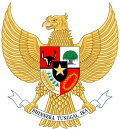Javanese Surinamese
ꦎꦫꦁꦗꦮꦯꦸꦫꦶꦤꦩꦺ Wong Jåwå Surinamè (in Javanese) Javaanse Surinamers (in Dutch) | |
|---|---|
Wayang Kulit played by Surinamese Javanese | |
| Total population | |
| c. 126,500 | |
| Regions with significant populations | |
| Paramaribo: 23,670 (10%) · Wanica: 21,175 (18%) · Commewijne: 14,829 (47%) | |
| 102,000 (2019)[1] (ancestries with people from Java, including Javanese, Sundanese, Chinese-Indonesians, Madurese and mixed racials)
88,000–90,000 (2022)[2] (Javanese Surinamese only) | |
| 21,700 (2008)[3][4] | |
| 3,000 | |
| 2,800 | |
| Languages | |
| Surinamese-Javanese · Dutch · Sranan Tongo, Indonesian, French | |
| Religion | |
| Majority: Sunni Islam 67.0% Minority: Christianity 21.4%, Kejawèn 5.6%, Hinduism 1.2%, No religion 2.8%, Other 0.8%, Unknown 1.2% | |
| Related ethnic groups | |
| Javanese · Javanese French Guianans | |
Javanese Surinamese are an ethnic group of
History

After the abolition of slavery, the plantations in

The workers most came from villages in
The immigrants were recruited to work on the plantations. The exception was a group in 1904, when 77 Javanese were recruited specifically to work at the Colonial Railways. From World War I Javanese also worked at the Suriname Bauxite Company in Moengo. Immigration continued until 13 December 1939. The outbreak of World War II ended transplantation schemes.
Population
A total of 32,965 Javanese immigrants went to Suriname. In 1954, approximately 1,000 Javanese returned to Indonesia, with the rest remaining in Suriname. The census of 1972 counted 57,688 Javanese in Suriname, and in 2004 there were 71,879. In addition, in 2004 more than 60,000 people of mixed descent were recorded, with an unknown number of part Javanese descent.
- Sunni Islam (64.21%)
- Christianity (14.46%)
- Buddhism (5.59%)
- Hinduism (1.23%)
- Irreligion (1.82%)
- Unknown (9.27%)
- Not Answered (0.13%)
- Others (3.25%)
Diaspora
In 1953, a large group of 300 families (1,200 people), led by
In the 1970s, 20,000–25,000 Javanese Surinamese went to the Netherlands. They settled mainly in and around cities such as
Notable people
- Karin Amatmoekrim, writer
- Reinier Asmoredjo, painter
- Maarten Atmodikoro, football player
- Andy Atmodimedjo, football player and manager
- Sigourney Bandjar, football player
- Dylan Darmohoetomo, badminton player
- Bruce Diporedjo, football player
- Salikin Hardjo, social activist and Indonesian repatriate
- Soeki Irodikromo, painter and ceramics artist
- Frits Karsowidjojo, politician
- Neraysho Kasanwirjo, football player
- Werner Kioe A Sen, brigade general and Commander of the Armed Forces
- Ranomi Kromowidjojo, swimmer
- Jeroen Lumu, football player
- Sri Dewi Martomamat, Miss Suriname in Miss Supranational 2019
- Soerjani Mingoen-Karijomenawi, politician
- Jaden Montnor, football player
- Vangelino Sastromedjo, football player
- Darren Sidoel, football player
- Iding Soemita, politician
- Willy Soemita, politician
- Virgil Soeroredjo, badminton player
- Paul Somohardjo, politician
- Jayden Turfkruier, football player
- Mitchel Wongsodikromo, badminton player
References
- ^ "Suriname". The World Factbook. Central Intelligence Agency. 18 December 2019. Retrieved 23 December 2019.
- ^ "Indonesia Suriname To Enhance Economic And Socio Cultural Cooperation | Portal Kementerian Luar Negeri Republik Indonesia". kemlu.go.id. Retrieved 27 February 2022.
- ^ Ko Oudhof, Carel Harmsen, Suzanne Loozen en Chan Choenni, "Omvang en spreiding van Surinaamse bevolkingsgroepen in Nederland Archived 2015-08-18 at the Wayback Machine" (CBS – 2011)
- ^ Ko Oudhof en Carel Harmsen, "De maatschappelijke situatie van Surinaamse bevolkingsgroepen in Nederland Archived 2015-08-18 at the Wayback Machine" (CBS – 2011)
- ^ Aris Ananta, Evi Nurvidya Arifin, M Sairi Hasbullah, Nur Budi Handayani, Agus Pramono. Demography of Indonesia's Ethnicity. Singapore: ISEAS: Institute of Southeast Asian Studies, 2015. p. 270 (based on 2010 census data).
- Bersselaar, van den, D., H. Ketelaars, 1991, De komst van contractarbeiders uit Azië: Hindoestanen en Javanen in Suriname, Leiden, ISBN 90-5292-037-0
- Breunissen, K., 2001, Ik heb Suriname altijd liefgehad: het leven van de Javaan ISBN 90-6718-183-8
- Bruin, de, H., 1990, Javanen in Suriname, Paramaribo
- Derveld, F.E.R., 1982, Politieke mobilisatie en integratie van de Javanen in Suriname : Tamanredjo en de Surinaamse nationale politiek, Groningen: Bouma's boekhandel, ook verschenen als proefschrift Leiden, ISBN 90-6088-078-1
- Grasveld, Fons en Klaas Breunissen, 1990, Ik ben een Javaan uit Suriname, Hilversum: Stichting Ideële Filmprodukties, ISBN 90-900360-0-8
- Hardjomohamed, R., 1998, Javanese female immigrants in the historiography of Suriname, Suriname
- Hoefte, R., 1990, De betovering verbroken: de migratie van Javanen naar Suriname en het rapport-Van Vleuten (1909), Dordrecht, ISBN 90-6765-458-2
- Hoefte, R., 1998, In place of slavery: a social history of British Indian and Javanese laborers in Suriname, Gainesville, ISBN 0-8130-1625-8
- Jorna, E., 1985, "Naar een land van melk en honing?": Javaanse emigratie naar Suriname 1890–1917, Leiden, doctoraalscriptie
- Kempen, M. van, 2003, 'Javanen'. In: Een geschiedenis van de Surinaamse literatuur. Breda: De Geus, pp. 197–209. (overzicht van de Surinaams-Javaanse orale literatuur)
- Mangoenkarso, P.P., 2002, De eerste 94 Javanen op plantage Mariënburg in Suriname, Rijswijk
- Mitrassing, F.E.M., 1990, Etnologische trilogie: Suriname: Creolen, Hindostanen, Javanen: gedenkschriften, Paramaribo
- Mulder, K., 1987, Reserve-arbeid in een reserve-kolonie: immigratie en kolonisatie van de Javanen in Suriname 1890–1950, Rotterdam, doctoraalscriptie.
- Six-Oliemuller, B.J.F.G., 1998, Aziaten vergeleken: Hindoestanen en Javanen in Suriname, 1870–1875, Leiden, doctoraalscriptie
- Suparlan, P., 1995, The Javanese in Suriname: ethnicity in an ethnically plural society, Tempe
- Vruggink, Hein i.s.m. John Sarmo, 2001, Surinaams-Javaans – Nederlands Woordenboek, ISBN 90-6718-152-8
- Waal Malefijt, de, A., 1963, The Javanese of Surinam, Assen
- Waal Malefijt, de, A., 1960, The Javanese population of Surinam, Colombia
- Wengen, van, G.D., 1975, The cultural inheritance of the Javanese in Surinam, Leiden, ISBN 90-04-04365-9
- Winden, van der, Y., 1978, Javanen in Suriname: bibliografie van publicaties verschenen over de Javaanse bevolkingsgroep in Suriname, Den Haag
- Villerius, S. E. (2019). Development of Surinamese Javanese: Language contact and change in a multilingual context (Ph.D. thesis). Radboud University. ISBN 978-94-6093-313-4.

